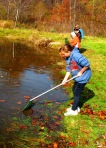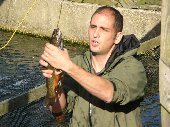You are currently browsing the category archive for the ‘nature study’ category.
 An exercise that I do with my (mostly adult) students is The Science Toolkit. I give them an iron nail and one meter of cotton postal string in a Ziploc bag and have them go outside for twenty minutes and see what they can use these items for.
An exercise that I do with my (mostly adult) students is The Science Toolkit. I give them an iron nail and one meter of cotton postal string in a Ziploc bag and have them go outside for twenty minutes and see what they can use these items for.
They always are surprised at how useful this simple toolkit can be. They use the nail to dig, and the string to mark off a study area; tie the string to the nail and use their newly made device to scratch circles on pavement or in soil; collect samples in the Ziploc bag; and lots more.
The exercise concludes with participants suggesting additional items to include in their kits. A magnifier, a permanent marker to mark their strings to be used for linear measurements, and other items are proposed and participants customize the kits for their own purposes.
These toolkits become part of our equipment and we carry them everywhere. I once gave a class the task of exploring the flora and fauna around a brand new school building in the Mojave Desert. The building had not even been around long enough to be populated by spiders, lizards and the other common life forms that make the human habitat their own. One particularly resourceful group of students searched and searched until they heard water flowing in a storm drain below their feet. They took the thimble-like cap off of a water bottle, untwined the strands of the cotton string and made a basket that they lowered down into the drain to collect a sample of water. Once inside, they examined the water with a microscope and discovered a rich array of microorganisms to study.
When to introduce the toolkit is a critical decision. It may be a great introduction to the creative and accessible activities of the scientist that we all can do, but it may require some rapport to be established between teacher and students to ensure buy-in and willingness to try something that may seem a little silly when you hand them a bag with a nail and a string. We often finish by constructing a list of additional items that participants would include in their own kits for their own needs (e.g., a mirror, a magnet, a hand lens, waterproof paper and pencil).
[Note: The toolkit was suggested by a hydrologist from the Clark County (Nevada) Water District–it is similar to one he carries with him at all times. The activity was developed by Bradley Iverson, of the Clark County School District, and me.]

Discomedusae by Ernst Haeckel
As the 20th century began, the influential and often controversial biologist and philosopher, Ernst Haekel was documenting the living organisms he was studying by creating beautiful, detailed plates like the one to the left. Take a look at his Kunstformen der natur (1904).
Artist and scientist often reside in the same person, each aspect illuminating the other. Albrecht Dürer, John James Audubon and countless others have simultaneously observed, documented and marveled at the natural world.
Explore the work of Edward Weston, Ansel Adams, Eadweard Muybridge, Ron Mueck, Joseph Albers, and think about the intersections between arts and sciences. This is not even taking into account artists not strictly in the visual camp (e.g., Pilobolus Dance Theater, John Ford, etc., etc.). Also, virtually every composer of music explores the biology, physics, mathematics and psychology of sound whether consciously or unconsciously.
Science and mathematics often are selected for integration in curricula because they are seen as an obvious pair. The arts, even when taken seriously–not as an add-on or an extra–too rarely articulate with the sciences in schools. A little effort, a little planning time, opportunities for arts and science teachers to experience each other’s work and talk about it may lead to synergy that will ignite the pedagogical lives of educators and artists to generate exciting and meaningful learning experiences for students.
For example, an artist/art teacher and a scientist/science teacher can develop a series of field trips to museums, and local forests or natural areas. Pre-trip, trip, and post-trip experiences can be planned, conducted, analyzed, reflected upon and shared with colleagues. Such a first step could be of any scope and may even start here among the readers of and contributers to this blog.
Anyone out there up for a little adventure? Summer is coming and offers us time for leisurely planning and this project may provide us with an excuse for a few trips to the museum and a few hikes in the woods. Anyone?
Among the wonderful resources available from the Cornell Lab of Ornithology is All About Birds, an online guide to birding, that enables you to search for birds by name, or browse the guide by name, taxonomy or silhouette. Your search is rewarded by a detailed “field guide-like” page that includes identification information, range maps, life histories and behavior, audio and video.

Also included at the site are Birding Basics, information on getting started in birding, photographing birds and more. The Living Bird link leads to tons of articles on every aspect of birds and birding including art, history and science. The Get Involved link provides advice and information about “citizen-scientist” programs and other opportunities.
For those looking for a good resource that can be used in the field, check out iBird, a field guide application currently available for the Android and the iPhone, but surely will be made available on other platforms in the future.

Outstanding Science Tradebooks for Students K-12 is NSTA‘s yearly annotated bibliography of science books for kids. These books are selected for being “accurate, up-to-date, and attractive” as well as accessible. Reading level suggestions and links to additional resources are included. Lists are available for every year from 1996 to 2009.
Within the past week the 3rd and 4th grades have made visits to the Cold Spring Harbor Fish Hatchery on Long Island. While it’s a rather long bus ride to get there, it’s definitely worth the trip. The hatchery has an amazing display of fish, amphibians, and reptiles, all of which are native to New York. Students get to spend part of their time simply exploring the different tanks and seeing these creatures up close.
The major focus of the trip this year was for students to learn more about trout. The first part of the program consists of an introduction by a hatchery staffer and then a short documentary film on the life cycle of a trout. The film helps students realize how difficult (and unlikely) it is for a trout to survive from egg to adult. They are introduced to the ideas that circumstance, timing, and natural selection all play a role in survival of a particular animal. Some trout eggs get swept downstream or eaten by predators. Newly hatched trout may develop a physical abnormality (like two heads!), and throughout each life phase, the fish faces different predators – from water scorpions to other trout to humans. The likelihood of a single trout egg surviving to adulthood is only about 3%, which makes our Trout in the Classroom program even more essential for encouraging this native species survival in the future.
After the film, students get to ask all sorts of questions while looking at preserved examples of trout at their different stages of existence. Then, its’ out to the trout pools, where a staffer demonstrates how the hatchery harvests eggs to be raised. Students learn how to distinguish between male and female trout (hint: look for a hook style jaw on the male vs. a straight jaw on the female). Eggs are squeezed out of the female into a wet metal bowl. Then, the milt (sperm) is squeezed out of the male over the eggs to fertilize them. After a few minutes the eggs are covered cold water to “harden” them and make them more durable to the elements.
It is some of these very eggs that get put into a glass jar and transported back to our school to be raised all winter and spring in the Common Space. Students will spend time each week recording the survival rate, keeping track of the health of the tank water, and then following the trout as they reach milestones in their life cycle. One of the most amazing sights to see is an older Bronx New School student stopping by the trout display and engaging a younger student in a conversation about trout and what is happening inside that tank.
Once again fifth-grade classes at BxNS made a three-day trip to Clearpool Education Center. As usual, it was a rich and valuable learning experience for students and teachers, and, we hope, the Clearpool staff.

Macro Pond Study
The outdoor/science educators at Clearpool are a varied group, each with her/his own unique set of strengths – both in terms of content and pedagogy. They are responsive to our needs as a school and are open about areas that they perceive as challenges. They are eager to talk science and talk education. They constantly seek to improve their practice both during the course of the three-day session and over the years we have been associated with them. Although our two institutions could both gain and contribute more without the burdens of limited budgets and limited time, the Bronx New School-Clearpool relationship is a true partnership from which all of us benefit in both tangible and less-easily defined ways.

Notebook Entry
The menu of classes and activities: games; team-building; low-ropes course; soil study; wastewater treatment; micro/macro pond life; forest ecology, and discovery hike seemed better integrated than I remember in years past—all built upon each other and upon things learned at school to help paint a larger, less-compartmentalized picture of the world and its interrelatedness.
Team-building was especially successful this time. Although difficult, and maybe not as fully realized as we might have hoped, seeds were planted in fertile ground as children faced themselves and began to deal with issues associated with being individuals within a community. We will exploit these experiences throughout the year as we prepare our children for middle school and for the world beyond school.
Children who sometimes have a difficult time within the strictures and boundaries they encounter in school are able to find strengths, abilities and success in the very different physical, intellectual, and emotional landscape they encounter at Clearpool. Children who know the school game and know how to succeed in that environment were removed from their comfort zone and had to search within themselves for skills and abilities they didn’t even know they had, as they were challenged by the unfamiliar situations presented to them at Clearpool. All teachers and students learned to see each other in new ways and to develop and cement new, more three-dimensional relationships. As with any experience, we, as professional educators, must reflect deeply on the Clearpool experience in order to benefit from it most fully. Let’s keep this conversation going and begin to plan for next year right now.
One of the ironies of schooling is that we try to educate children about the world and prepare them for a satisfying productive life in that world, by removing them from that world and taking them into our school building. Clearpool, the park study, neighborhood studies, and work in the school garden are some of our efforts to go out into the exciting and sometimes chaotic real world and learn there.



Recent comments